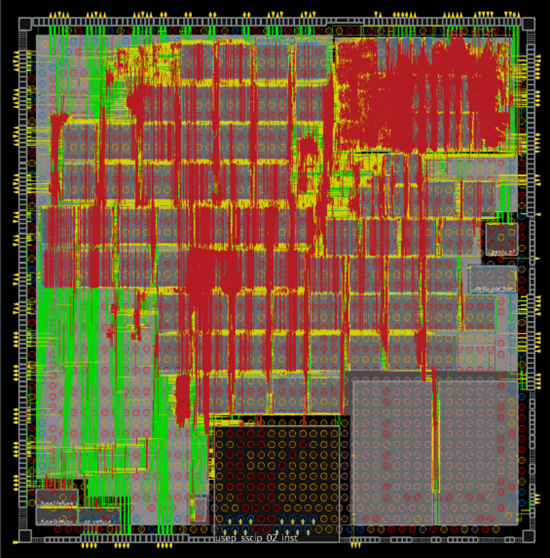Ganymed SoC

Overview
The Ganymed® SoC is an embedded multicore RISC-V SoC with outstanding performance and level of security. The SoC design includes nine processing core, divided into a Data Acquisition Unit (DAQU) with one core and a Data Processing Unit (DPU) with eight cores. The RV32 based processor architecture distinguishes into different privileged operating modes to allow real Trusted Platform Computing into the edge. Sensry provides a Zephyr® RTOS based board support package for fast solution integration. Also, we offer embedded programming services to support the final application.
General Features
- Multi-Core RISC-V performance for smart edge computing and AI applications
- Produced in Europe in latest 22FDX technology
- Support of multiple communication standards
- Low power consumption
- Adequate memory resources
- Inherent multi-layer data security and authentication
- Zepyhr® RTOS based board support package available
- Integration in fog, edge and cloud computing
- Optional hardware and software integration support from Sensry
Core Features
- RISC-V based cluster core running at max. 500MHz
- Data acquisition Unit (DAQU) with FPU
- Single RI5CY Core (RV32IMCXpulp)
- Data Procsssing Units (DPU) with FPU
- 8 RI5CY cores for parallel operation (8 x RV32IMFCXpulp)
- Included basic and advanced timers
- 256kB Tightly-Coupled Memory (TCDM)
- 512Byte instrucation cache for each core (4kB)
- All cores running at max. 500MHz
- Event bus
- MicroDMA
- Security features
- Life-Cycle & Run-Time Management
- Crypto Co-Processor
- True Random Number Generator (TRNG)
- One-Time-Programmable Memory (OTP) for Keys and Certificates
- Interfaces:
- 3x UART (up to 2Mbit/s, two of them with hardware handshake)
- 4x I2C (up to 400kHz)
- 4x I2S
- 7x SPI (up to 50MHz)
- 1x CAN-FD
- 1x RGMII Ethernet Time Sensitive Networking
- Debug JTAG
- Analog Intefaces
- 25MS/s 12bit High Speed SAR ADC
- 100kS/s 11bit Ultra Low Power SAR ADC
- 16Bit Sigma Delta ADC (Audio)
- 32x GPIO
- Each interface (except GPIO) can be induvidually disabled for power saving
- Memory
- 512 kB Secure MRAM
- 512 kB MRAM
- 64 kB Secure SRAM
- 4096 kB SRAM
- Individual Data & Instruction Cache for DPU cores
Power
Four different power domains and one reference voltage are required for the Ganymed® system.
| Power domain | Value |
|---|---|
| Core Voltage | 0.8 V |
| I/O Voltage | 1.8 V / 3.3 V |
| MRAM ref voltage | 0.6 V |
| Analog Subsystem | 0.8 V / 1.8 V |
| max. Power dissipation | < 1 W |
Clocks
The CPU clock frequency can be set exclusively by the DAQU CPU core. All DPU cores operate at the same clock frequency (unless disabled), while the DAQU core frequency may be different.
| Clock domain | Value |
|---|---|
| Low power operation clock/boot clock | 32.768 MHz |
| System reference clock | 25 MHz |
| System clocks (internal) | Generated from external clock via PLL,as required for functional units |
| CPU Clock | max. 500 MHz |
All the internal clocks are derived from a single PLL operating at a VCO clock source of 2 GHz generated from an extern reference clock of 25MHz. Most of the internal clock dividers are configurable. The DAQU and the peripheral logic can be multiplexed into the 25MHz reference clock domain to provide basic functionality if the PLL and clock dividers are uninitialized.
The following table describes the standard boot values for the clock divider:
| Clock domain | Default Reset Value |
|---|---|
| DAQU main SoC Clock | 100 MHz |
| DPU Clock | 100 MHz |
| Peripherals Clock (Including Ethernet) | 125 MHz |
| CAN-FD Clock | 80 MHz |
| MRAM Clock | 20 MHz |
| TRNG sample Clock | 100 MHz |
| High-Speed SAR ADC Clock | 500 MHz |
| Ultralow-Power SAR ADC Clock | 2.5 MHz |
| Delta Sigma ADC Clock | 12.5 MHz |
Memory architecture
The RISC-V architecture allows to run the SoC in different operation modes. In the Ganymed SoC, two modes are implemented:
- Machine Mode: Exclusive access to secure memory areas (512 kB MRAM + 64 kB SRAM) and access to global memory (512 kB MRAM + 4 MB SRAM)
- User Mode: Limited access only to global memory (512 kB MRAM + 4 MB SRAM)
For further questions, development, and programming support, and for access to our dedicated Gitlab repository, please contact our support via support@sensry.de.